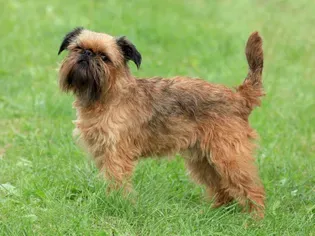Brussels Griffon (Griff): Dog Breed Characteristics & Care
Updated on 05/27/24

Brussels Griffon (Griff): A Charming and Affectionate Companion
Introduction
The Brussels Griffon, affectionately known as the Griff, is a small, charming breed that originated in Belgium in the late 19th century. With their distinctive human-like expression, lively personalities, and unwavering loyalty, Griffons have captured the hearts of dog enthusiasts worldwide. This comprehensive guide delves into the unique characteristics, care requirements, and charming quirks of this beloved breed.
Physical Characteristics
* Size: Small, weighing between 3-6 kg (6-13 lbs)
* Height: 18-20 cm (7-8 inches) at the shoulder
* Coat: Short, rough, and wiry, available in red, black and tan, and belge (fawn)
* Head: Large, round with a short muzzle and prominent eyes
* Ears: Erect and triangular, resembling those of a bat
* Tail: Docked or natural, carried high and straight
Temperament
Griffs possess a lively and affectionate temperament. They are:
* Loyal and Devoted: They form strong bonds with their owners and are highly protective.
* Intelligent and Trainable: Despite their small size, Griffs are quick learners and respond well to positive reinforcement.
* Playful and Energetic: They enjoy interactive games and long walks.
* Independent: They can be somewhat independent, but they also thrive on companionship.
* Vocal: Griffs are known for their distinctive "bark-honk" and may alert their owners to strangers or unusual noises.
Care and Grooming
* Feeding: Griffs require a high-quality diet tailored to their small size and active lifestyle.
* Exercise: They need regular exercise to stay healthy and happy. Daily walks, playtime, and interactive games are essential.
* Grooming: Brush their coat weekly to remove loose hair and prevent mats. Regular baths are also necessary to maintain hygiene.
* Health: Griffs are generally healthy dogs, but they may be prone to certain genetic conditions, such as eye problems and patellar luxation (slipping kneecaps). Regular vet checkups are crucial for early detection and treatment.
Training and Socialization
* Training: Begin training early using positive reinforcement methods. Focus on basic obedience commands, such as sit, stay, come, and heel.
* Socialization: Expose your Griff to various people, animals, and environments from a young age. This will help them develop good manners and reduce fear or aggression.
Pros and Cons of Owning a Brussels Griffon
Pros:
* Affectionate and loyal
* Intelligent and trainable
* Easy to groom
* Relatively long lifespan (12-15 years)
* Suitable for apartment living
Cons:
* Can be stubborn and independent
* Prone to barking
* May have genetic health conditions
* Require regular exercise
Examples of the Brussels Griffon's Unique Traits
* "Monkey Face": Their human-like facial expression with prominent eyes and a mischievous grin has earned them the nickname "monkey face."
* "Bark-Honk": Their distinctive vocalization resembles a combination of a bark and a honk.
* "Velcro Dog": Griffs are known for their clingy and affectionate nature, earning them the nickname "Velcro dog."
* "Brussels Lace": Their fine, lace-like hair around the neck and chest is a unique and charming feature.
* "Ewok Look": Their wiry coat and erect ears often draw comparisons to the furry creatures from the Star Wars franchise.
Conclusion
The Brussels Griffon is an endearing and spirited companion that makes an excellent addition to any family. Their loyalty, affection, and lively personalities bring joy and laughter into the lives of their owners. By providing them with proper care, training, and socialization, you can enjoy a long and fulfilling relationship with your charming Griff.
Explore More Pets

Basic Training
Puppy and Baby Introductions

Working Dog Breeds
All About Search and Rescue Dogs

Dog Treatments
Puppy Vaginitis: Signs, Causes and Treatment

Dog Adoption
After More Than 1,200 Days in the Shelter, Coco Goes Home

Basic Training
How to Train Your Puppy to Go on Potty Pads

Hybrid Dog Breeds
The Difference Between a Mutt, Mixed Breed, or Designer Dog?

Dog Treatments
Nail Problems in Dogs

Puppies
7 Reasons Why Two Dogs Are Better Than One
